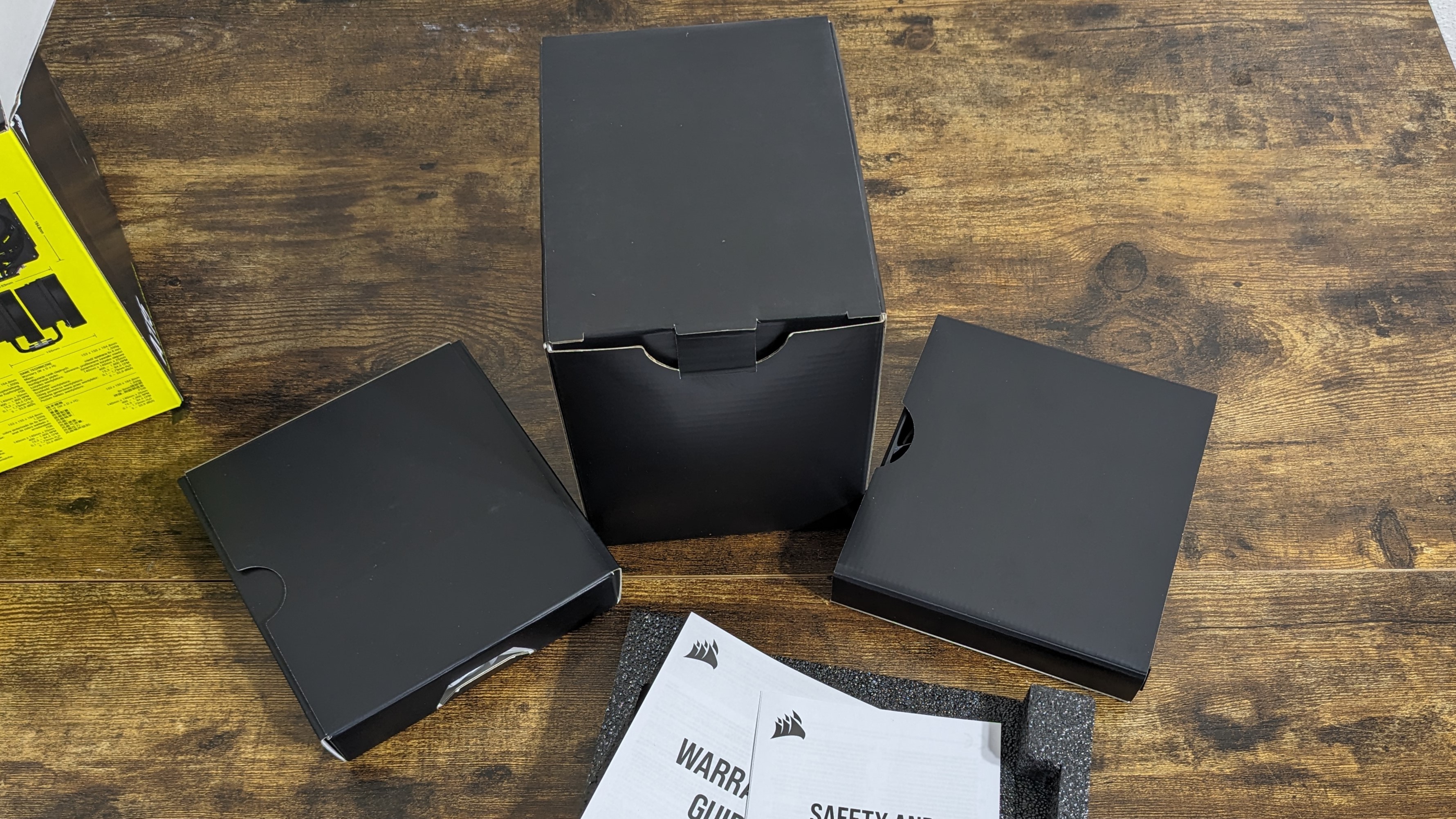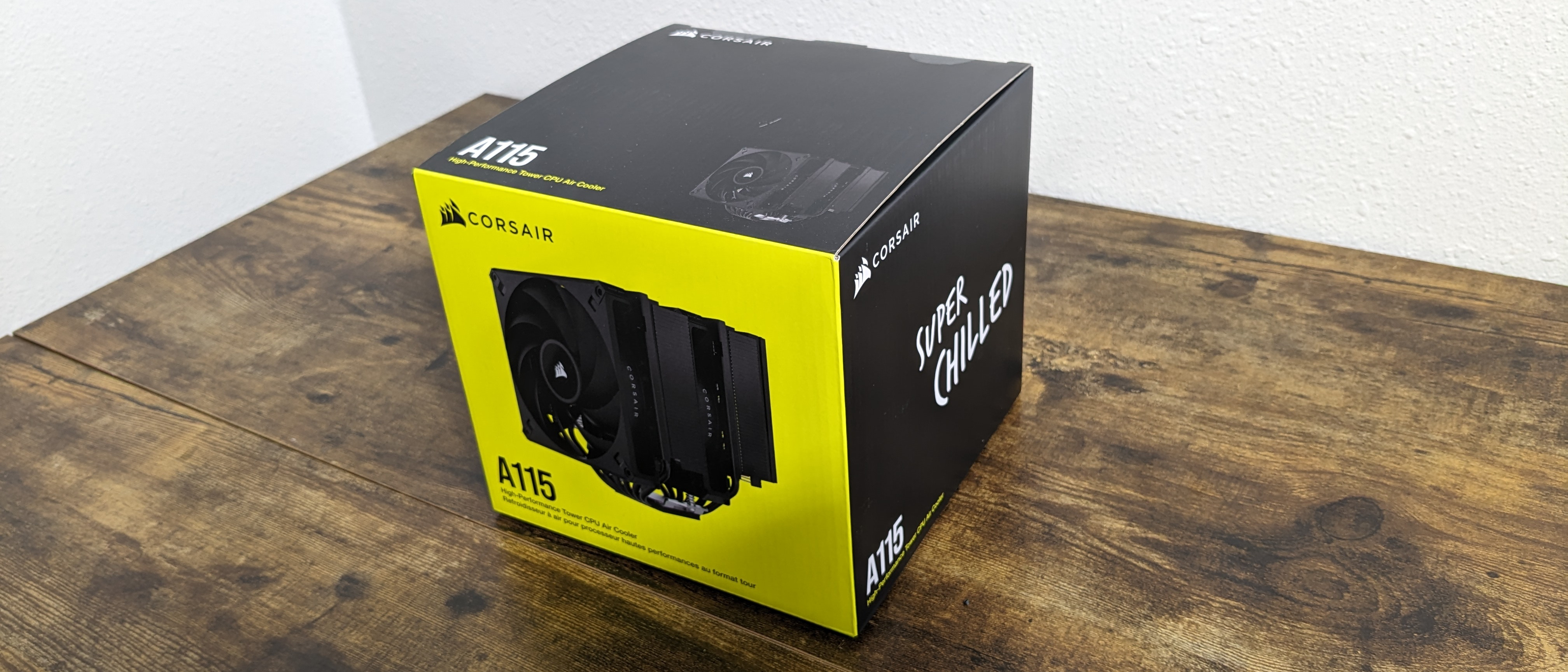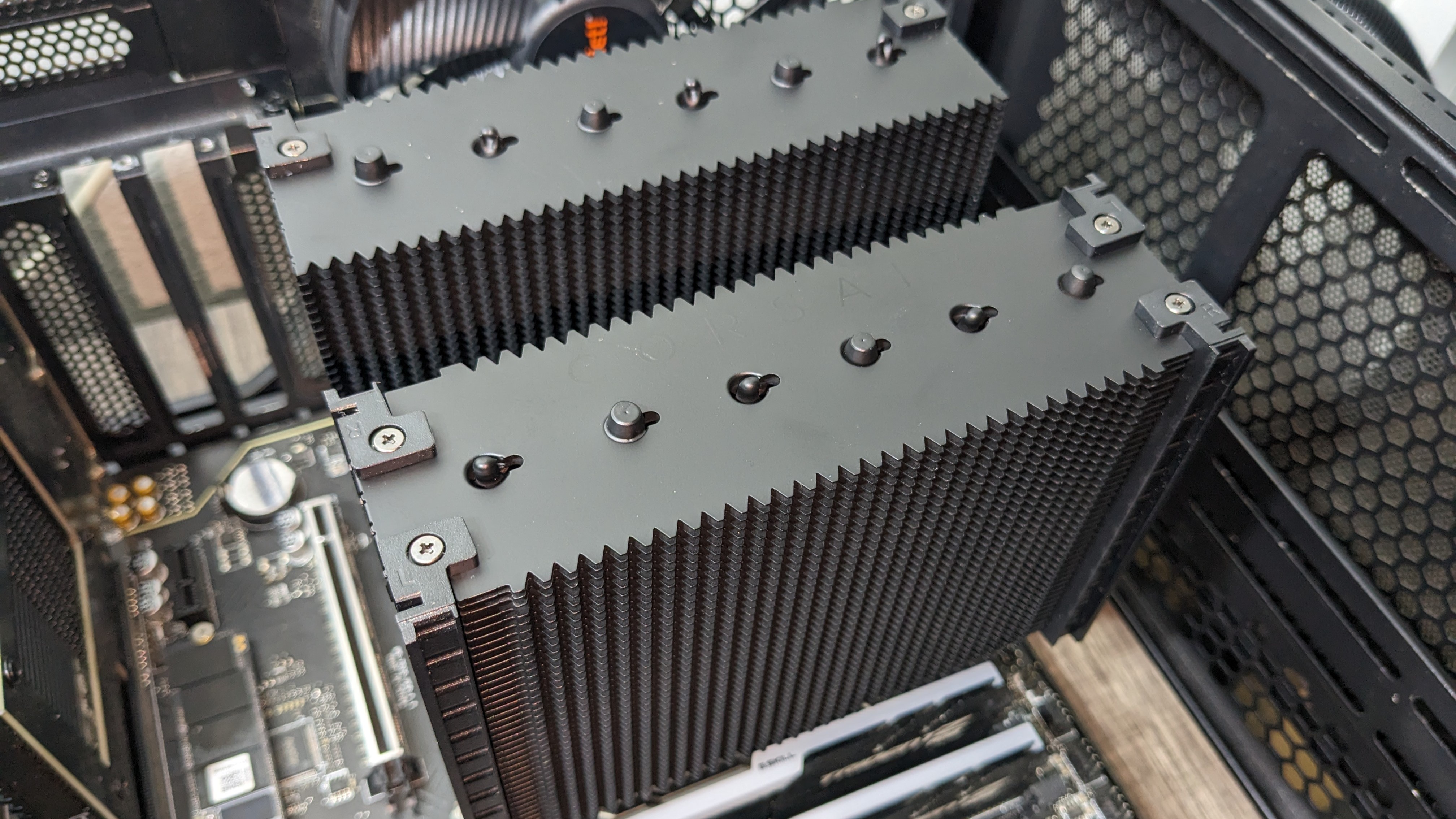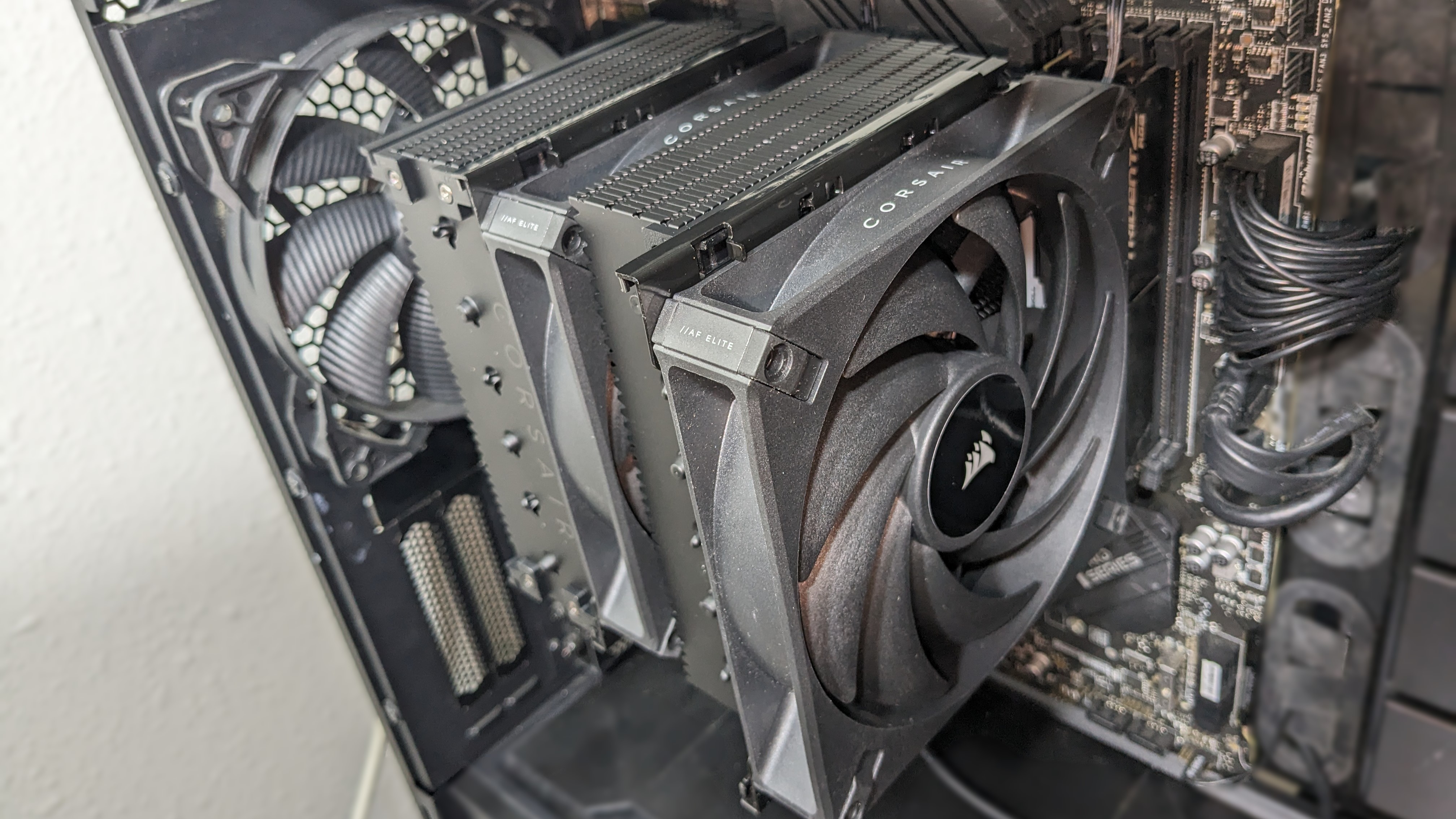Tom's Hardware Verdict
Corsair’s new A115 big air cooler dominates our thermal benchmarks and runs quietly. And the fan slider system makes installation easier. When you consider all of the factors including noise, this is one of the best air coolers I’ve had the pleasure of testing. However, at $99.99 USD, it’s not budget in any sense of the word.
Pros
- +
Chart-topping thermal performance
- +
Low noise levels
- +
Innovative fan sliders
Cons
- -
High price
Why you can trust Tom's Hardware
Corsair’s come a long way since its 1994 debut selling L2 cache modules for OEMs. Today the company offers a wide variety of components and peripherals, like the Corsair 5000X case and CX750M Power Supply. Cooling has also been a staple of the company's lineup for a long time, with its flagship iCUE H170i Elite LCD XT proving to be the strongest AIO cooler we’ve tested thus far with Intel’s i9-13900K.
While Corsair has released a variety of new AIOs in recent history, it’s has been a while since has launched a new air cooler. That changes today with the A115 dual tower air cooler, which aims to compete with the current kings of air cooling like DeepCool’s Assassin IV and Thermalright’s Frost Commander 140. Does the A115 have what it takes to earn a spot on our best coolers list? We’ll have to put it through testing to find out. But first, here are the specifications from Corsair.
Cooler specifications
| Cooler | Corsair Air A115 |
| SKU | CT-9010011-WW |
| MSRP | $99.99 USD |
| Heatsink Material | Aluminum |
| Rated Lifespan | Unlisted |
| Socket Compatibility | Intel Socket LGA 115x/1200/1700 AMD AM5 / AM4 |
| Base | Nickel-Plated Copper |
| Max TDP (Our Testing) | ~250W with Intel’s i7-13700K |
| Installed Size (with fans) | 153mm (L) x 155 mm (W) x 164.8mm (D) |
| Warranty | 5 years |
Packing and included contents
The cooler arrives in a large-ish box, with the contents protected by cardboard, molded foam, and plastic.
Included with the cooler are the following:
- Dual-Tower heatsink
- 2x 140mm Corsair AF140 Elite fans
- Mounting for modern AMD and Intel Platforms
- Pre-applied Thermal Paste
- PWM splitter cable


LGA 1700 installation
Installation of the Air A115 is fairly simple for an air cooler.
1. Press the backplate against the rear of the motherboard, and then secure it using the included standoffs.
2. Place the mounting bars against the standoffs, and then secure them with the included thumbscrews.
Get Tom's Hardware's best news and in-depth reviews, straight to your inbox.
3. You can skip thermal paste application here, since it comes pre-applied on this cooler. But if you mess that up or want to apply your own, see our How to Apply Thermal Paste primer.
4. Place the heatsink on top of the mounting bars and secure it to the mounting bars with a screwdriver.
5. Slide on both of the fans, then connect them to the PWM splitter cord. Connect the PWM splitter to your motherboard, and installation is complete.
Features of Corsair’s A115 Dual-Tower Air Cooler
Six copper heatpipes, pre-applied thermal paste
Corsair’s A115 transfers heat by incorporating six copper heatpipes, and has pre-applied thermal paste to make installation easier
Dual-tower heatsink
In conjunction with the 6 copper heatpipes, Corsair’s A116 has dual-tower heatsinks with jagged fins to increase surface area and move heat away from your CPU.


Sliding fan system
Most air coolers on the market use old-fashioned fan clips, which generally work fine but have a few drawbacks. Corsair’s A115 utilizes a fan slider system to allow for easier installation. The slider brackets can easily be installed on other fans, so you won’t be locked into the included AF140 fans if you want to use another model of fan instead.
Full RAM compatibility, with a catch
Due to the use of a sliding fan system, the A115 technically is fully compatible with any size of RAM. However, if you have one of the fans overhanging the RAM, you won’t be able to push the fan all the way down unless your RAM is shorter than 40mm. This may result in slightly lowered cooling capacity. If this is a concern for you, one can always attach one of the fans to the rear of the unit instead of the front.
High-performance AF140 Elite 140mm fans
I say this on almost every cooler review, but there’s more to a cooler than just the heatsink or radiator. The bundled fans have a significant impact on cooling and noise levels, as well as how the cooler looks in your case.
I only have one concern with the AF140 fan: Corsair doesn’t list a MFFT in the technical specifications, which can sometimes – but not always – indicates a poor-quality fan. However, the construction of these fans is sturdy, with minimal bending with pressure applied, and Corsair backs the entire air cooler – including the fans – with a 5-year warranty.
| Model | AF140 Elite |
| Dimensions | 140 x 140 x 25mm |
| Fan Speed | 400-1600 RPM ± 10% |
| Air Flow | Up to 84.5 CFM |
| Air Pressure | Up to 1.73 mmH2O |
| Bearing Type | Fluid Dynamic Bearing |
| Lighting | None |
| MFFT | Unlisted |
LGA1700 Socket Bending
There are many factors other than the CPU cooler that can influence your cooling performance, including the case you use and the fans installed in it. A system's motherboard can also influence this, especially if it suffers from bending, which results in poor cooler contact with the CPU.
In order to prevent bending from impacting our cooling results, we’ve installed Thermalright’s LGA 1700 contact frame into our testing rig. If your motherboard is affected by bending, your thermal results will be worse than those shown below. Not all motherboards are affected equally by this issue. I tested Raptor Lake CPUs in two motherboards. And while one of them showed significant thermal improvements after installing Thermalright’s LGA1700 contact frame, the other motherboard showed no difference in temperatures whatsoever! Check out our review of the contact frame for more information.
Testing methodology
Today's highest-end CPUs, whether Intel or AMD, are difficult to cool in intensive workloads. In the past. reaching 95 degrees Celsius or more on a desktop CPU might have been a cause for concern. But with today’s top-end CPUs, this is considered normal operation. Similar behavior has been present in laptops for years due to cooling limitations in tight spaces.
All testing is performed with a 23C ambient room temperature. Multiple thermal tests are run on each CPU to test the cooler in a variety of conditions, and acoustic measurements are taken with each result. These tests include:
1. Noise normalized testing at low noise levels
2. “Out of the box”/Default Configuration Thermal & Acoustics Testing
a. No power limits enforced
b. Because CPUs hit Tjmax in this scenario, the best way to compare cooling strength is by recording the total CPU package power consumption.
3. Thermal & Acoustics testing in Power Limited Scenarios
a. Power limited to 175W to emulate a medium intensity workload
b. Power limited to 125W to emulate a low intensity workload
The thermal results included are for 10-minute testing runs. To be sure that was sufficiently long to tax the cooler, we tested both Thermalright’s Assassin X 120 R SE and DeepCool’s LT720 with a 30-minute Cinebench test with Intel’s i9-13900K for both 10 minutes and 30 minutes. The results didn’t change much at all with the longer test: The average clock speeds maintained dropped by 29 MHz on DeepCool’s LT720 and 31 MHz on Thermalright’s Assassin X 120 R SE. That’s an incredibly small 0.6% difference in clock speeds maintained, a margin of error difference that tells us that the 10-minute tests are indeed long enough to properly test the coolers.
Testing configuration – Intel LGA1700 platform
| CPU | Intel Core i7-13700K |
| Motherboard | MSI Z690 A Pro DDR4 |
| Case | Be Quiet! Silent Base 802, system fans set to speed 1 setting. |
| Monitor | LG 45GR95QE |
| PSU | Cooler Master XG Plus 850 Platinum PSU |

Albert Thomas is a contributor for Tom’s Hardware, primarily covering CPU cooling reviews.
-
dmitche3 "The cooler arrives in a large-ish box, with the contents protected by cardboard, molded foam, and plastic." I don't know about you but this sold me. Can't wait to get that box! AND with molded foam. It sells chills down my spine.Reply -
Tom Sunday In this case: My immediate reaction and 'buying decision making' would be in purchasing from NOCTUA. It’s not exactly that Corsair with the Air A115 has any new cooling rabbits or truly noteable cooling improvements in their black hat. Corsair here is essentially just regurgitating a proven dual-tower heatsink design which in principal has been around for many years past. And duplicated and proffered by dozens of other OEMs. The Air A115 also lists within in the $100 pricing range which for Corsair being a non OEM or just a basic component distributor, is exceedingly high and overpriced. I am also not sure why the review made such a big deal about the packaging…large box, molded foam and plastic not withstanding?Reply -
Albert.Thomas Guys,Reply
I briefly cover the packaging of every cooler I test. This ain't anything new. -
stewartwb Thermalright Phantom Spirit 120 for the win! Per this review, 1dBA quieter than the Corsair A115 at default fan curve. Within spitting distance on thermals (Only 0.5ºC warmer CPU temp at 175W limit.)Reply
Sliding brackets are cool, but 2.5 times the price? Really? Cost $41 in October 2023. Quietest cooler I've ever owned, even when encoding video on my Ryzen X5700. About as quiet as my son's Arctic Liquid Freezer II 280 AIO cooler. -
thestryker While the big expensive coolers do a really good job I feel like Thermalright has done a number on them. Thermalright is so much less expensive that it narrows an already narrow use case for them. Barring some sort of aesthetic (or brand preference, which I find silly, but understand everyone's different) preference I don't see why you would buy anything else prior to making the jump to AIO/custom loop cooling.Reply -
Amdlova Reply
I Got some dual tower cooler with some bend because some people tend to play soccer with the package.dmitche3 said:"The cooler arrives in a large-ish box, with the contents protected by cardboard, molded foam, and plastic." I don't know about you but this sold me. Can't wait to get that box! AND with molded foam. It sells chills down my spine. -
Tom Sunday ReplyAlbert.Thomas said:Guys,
I briefly cover the packaging of every cooler I test. This ain't anything new.
I agree with your packaging remark. No problem. But here is one for you. Times have a way of flying away from us! Not to forget that Scythe introduced the Mugen-2 CPU cooler 15 years ago. Advertised with excellent cooling performance, excellent workmanship, easy assembly and a super low price. WOW…the Mugen 2 had 'five separate cooling towers' and was then fundamentally very different from anyhing on the market at the time. Scythe attached great importance to the workmanship of the cooler, which was evident, for example, in the cleanly executed fin towers, the nickel-plated and perfectly flat copper base plate or the heat pipe end pieces. There were also changes to the mounting system of the Mugen 2. Instead of the comfortable push-pin system which is not suitable for heavier coolers, Scythe used a backplate and one of the industries first for mounting the Mugen 2.
Even under fair testing conditions the Mugen 2 was able to assert itself as the third most air powerful cooler in the testing line-ups. Even the somewhat more complicated assembly had its reasons and was preferable to a simpler and therefore less safe method. For me personally the Mugen 2 design format came very close in appearance and purpose to the much later introduced Noctua NH-P1 format and for the tower to do all of the heavy lifting. Except that Scythe threw-in and extra fan for good measure. Will history perhaps repeat itself?






